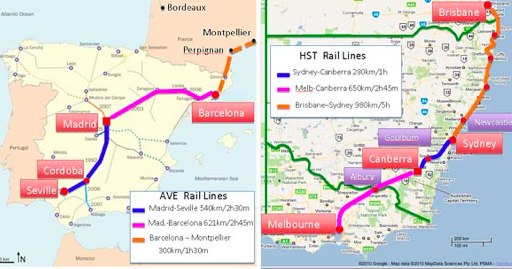But the best model for Australia to follow is Spain's, which has built two HST lines of 1161 kilometres linking Madrid to Seville (540 kilometres, opened 18 years ago) and Barcelona (630 kilometres). These distances, and as it happens the total population, served by the trains is quite comparable to the Australian SCM axis (see graphic). Based on the current French estimate of Euro 10 million/km ($A15 million/km) to build those lines today would be about $A17.4 billion; even allowing several billions more for stations and train sets it would be a struggle to spend even half the fictional $60 billion, perhaps $20-25 billion.
Contrary to misinformation concerning high speed rail in Australia, it is logistically, economically and even politically feasible. Australians are now receptive to such nation-building infrastructure, if only our politicians had the courage to sell the vision and could think beyond one or two electoral cycles. Economically it stacks up against continued spending on highway projects or hugely expensive airport upgrades, or the interminable wrangling over Sydney's phantom second airport. Dismissing the strategy of an expanded Canberra airport or a new one shifted closer to Sydney served by a 30-50 minute HST journey to the heart of Sydney and Canberra, is the same tired defeatism we have had for decades.The high-speed rail route would follow the existing Melbourne-Sydney route from Melbourne through to Albury, thence diverging eastward, passing through Canberra and Goulburn. A one-way trip between Melbourne and Sydney would take under five hours. (An eventual extension to Brisbane would theoretically take another five hours to traverse, though I imagine that they'd have to straighten the route out considerably from the existing one to achieve this; part of the high-speed rail formula is straighter tracks than conventional railways have.)
One interesting effect of high-speed rail in Australia would probably be the development of a commuter belt outside of the major cities, and corresponding relief for housing shortages (which are particularly acute in Melbourne these days). If Albury is 90 minutes away from Melbourne by train, it is just about conceivable that people might commute in from there. (The town of Seymour, on the existing Melbourne-Albury line, would be a mere 30-40 minutes from Melbourne by high-speed rail, and would be well poised to become a base for commuting to Melbourne.) Goulburn (and, eventually, Newcastle) could do the same for Sydney. There are precedents; one effect of the TGV lines in France is that towns on lines going to Paris have become parts of Paris' commuter belt.
Australia is probably better poised to develop large infrastructure projects than recession-hit Europe, currently floating on the (largely Chinese-fuelled) resources boom. Of course, knowing Australia (a place where short-termism and apathy rule even more than elsewhere), chances are high-speed rail will remain in the too-hard basket until the price of oil suddenly puts and end to $65 Virgin Blue flights, taking everybody by surprise because, while they might have known that oil prices were going to rise, they didn't expect it to actually affect them.
